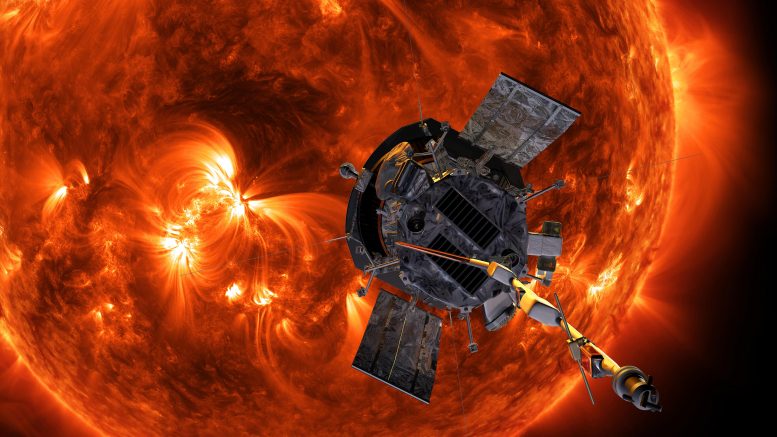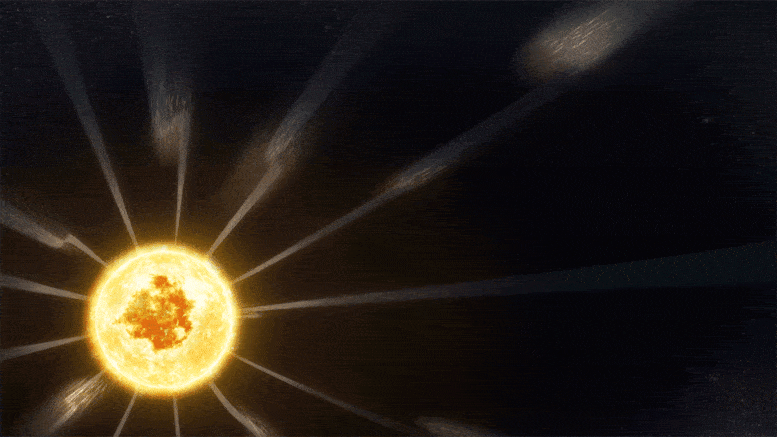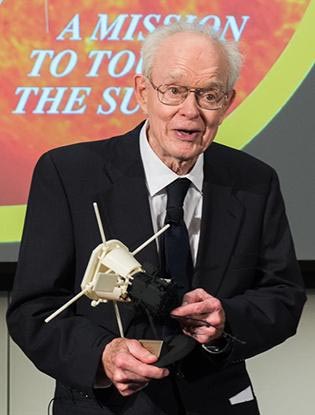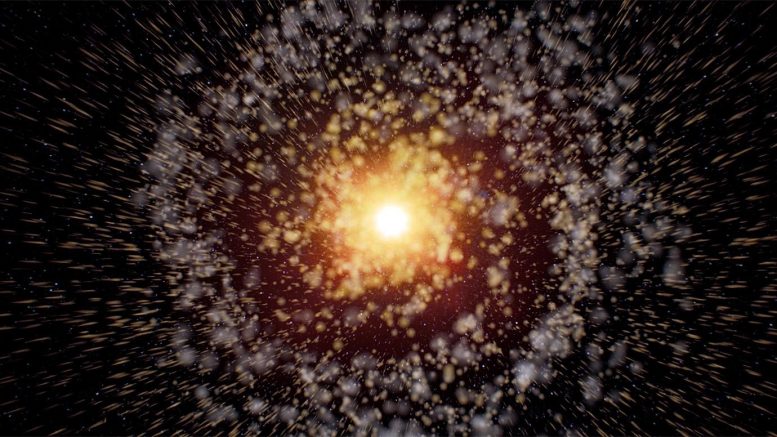
A rendering of Parker Solar Probe as it circles the sun—closer to a star than any spacecraft has ever ventured. Credit: NASA/Johns Hopkins APL/Steve Gribben
NASA mission named for pioneering University of Chicago scientist produces landmark research.
Last summer, NASA’s Parker Solar Probe split the predawn skies in a blaze of light as it headed closer to the sun than any other spacecraft. Named for pioneering University of Chicago astrophysicist Eugene Parker, the probe has now made three of its 24 planned passes through the sun’s corona—enough for scientists to announce their first discoveries.
In four papers published Dec. 4 in Nature, researchers describe strange space phenomena and a flood of new data that will help us understand everything from the nature of stars to improving our forecasting of solar storms that can affect electronics on Earth.
Sidling up to the nearest star that humans can reach, the Parker Solar Probe learned new information about two types of major space weather events. It also saw the first signs of the zone around the sun where cosmic dust disappears—predicted decades ago, but never seen—as well as an entirely new phenomenon: bizarre “switchbacks” in the solar wind that flows off the surface of the sun. Scientists said it will dramatically change our theories of the corona and solar wind.
Scientists are eager to learn more about the solar wind—a flow of charged particles off the surface of the sun which radically affects the Earth and the entire solar system, which University of Chicago Professor Emeritus Eugene Parker first proposed in 1958. NASA named the solar mission after the famed astrophysicist in 2017.
Parker, now 92, is poring over the probe’s early results with interest.
“Now that the data is finally coming in and being analyzed, things are getting really exciting,” he said. “We’ve already seen evidence for some very surprising phenomena—which you should always expect when you travel into regions where spacecraft have never been before. That is part of the excitement of these missions, and I’m looking forward to what comes next.”
“It is appropriate that a spacecraft named in honor of our colleague Eugene Parker, who made contributions across nearly all of heliophysics, should have findings that are so immediately diverse and interesting,” said Angela Olinto, dean of the Division of the Physical Sciences and the Albert A. Michelson Distinguished Service Professor in the Department of Astronomy and Astrophysics. “These findings represent an incredible opportunity to help us unravel the many mysteries that stars still hold.”
Solar mysteries
Though it may seem placid to us here on Earth, the sun is anything but quiet. Our star is magnetically active, unleashing powerful bursts of light, particles moving near the speed of light and billions of tons’ worth of material.
What happens on the sun is critical to understanding how it shapes the space around us. Most of the material that escapes it is part of the solar wind, a continual outflow of ionized gas, called plasma. This plasma carries with it the sun’s magnetic field, stretching it out through the solar system in a giant bubble that spans more than 10 billion miles.

A simulation of “switchbacks,” reversals in the direction of the magnetic field embedded in the solar wind. Credit: NASA’s Goddard Space Flight Center/Conceptual Image Lab/Adriana Manrique Gutierrez
Closer to the solar wind’s source, Parker Solar Probe saw a much different picture from the one we have on Earth: a complicated, active system. One event in particular drew the eye of the science teams: flips in the direction of the magnetic field, which flows out from the sun, embedded in the solar wind. These reversals, dubbed “switchbacks,” last anywhere from a few seconds to several minutes as they flow over Parker Solar Probe. During a switchback, the magnetic field whips back on itself until it is pointed almost directly back at the sun.
“Waves have been seen in the solar wind from the start of the space age, and we assumed that closer to the sun the waves would get stronger, but we were not expecting to see them organize into these coherent structured velocity spikes,” said Prof. Justin Kasper, AB’99, of the University of Michigan, a UChicago alum whose team helped build one of the instruments aboard the probe. “We are detecting remnants of structures from the Sun being hurled into space and violently changing the organization of the flows and magnetic field. This will dramatically change our theories for how the corona and solar wind are being heated.”
Shedding light on solar wind and dust
Another longstanding solar mystery is about how the solar wind flows out from the sun.
Near Earth, we see the solar wind flowing directly from the sun, straight out in all directions. But the sun rotates as it releases the solar wind, so at some point between the sun and Earth, the solar wind transitions from rotating along with the sun to flowing directly outward. Where that transition happens has implications for how the sun sheds energy; finding that point may help us better understand the lifecycle of other stars or the formation of planets.
For the first time, Parker Solar Probe observed the solar wind while it was still rotating. Parker Solar Probe’s solar wind instrument detected rotation starting more than 20 million miles from the sun, and as the probe approached, the speed of the rotation increased. The strength of the circulation was stronger than scientists had predicted.
“These findings represent an incredible opportunity to help us unravel the many mysteries that stars still hold.” — Angela Olinto, dean of UChicago’s Division of the Physical Sciences
“The large rotational flow of the solar wind seen during the first encounters has been a real surprise,” Kasper said. “While we hoped to eventually see rotational motion closer to the sun, the high speeds we are seeing in these first encounters is nearly ten times larger than predicted by the standard models.”
Another question approaching an answer is space dust—the cosmic crumbs of collisions that formed planets, asteroids, comets and other celestial bodies billions of years ago. Scientists have long suspected that, close to the sun, this dust would be heated to high temperatures by sunlight, turning it into a gas and creating a dust-free region around the sun. But no one had ever observed it.
For the first time, Parker Solar Probe actually saw the cosmic dust begin to thin out—a little more than 7 million miles from the sun. This decrease in dust continues steadily to the current limits of the probe’s measurements at a little more than 4 million miles from the sun.
Space weather insights
Finally, Parker Solar Probe’s measurements have given us a new perspective on two types of space weather events: energetic particle storms and coronal mass ejections.
Events on the sun can send energetic particles rocketing out into the solar system at nearly the speed of light. These particles carry a lot of energy, so they can damage spacecraft electronics and even endanger astronauts, especially those in deep space, outside the protection of Earth’s magnetic field. Parker Solar Probe’s instruments have measured never-before-seen energetic particle events—so small that all trace of them is lost before they reach Earth or any of our near-Earth satellites.
Instruments also provided unprecedented detail on coronal mass ejections, massive clouds of solar material that the sun sends hurtling out into the solar system. Coronal mass ejections can trigger a range of effects on Earth and other worlds, from sparking auroras to inducing electric currents that can damage power grids and pipelines. Looking alongside such events as they travel away from the sun, Parker Solar Probe has already shed new light on the range of events our star can unleash.
As Parker Solar Probe continues on its journey, it will make 21 more close approaches to the sun at progressively closer distances, culminating in three orbits a mere 3.83 million miles from the solar surface.
For more information and videos on the recent discoveries from the Parker Solar Probe, read 5 Astonishing New Discoveries From NASA’s Parker Solar Probe.
2019-12-30 11:47:25Z
https://scitechdaily.com/parker-solar-probes-first-discoveries-strange-phenomena-in-space-weather-solar-wind/
CBMibWh0dHBzOi8vc2NpdGVjaGRhaWx5LmNvbS9wYXJrZXItc29sYXItcHJvYmVzLWZpcnN0LWRpc2NvdmVyaWVzLXN0cmFuZ2UtcGhlbm9tZW5hLWluLXNwYWNlLXdlYXRoZXItc29sYXItd2luZC_SAXFodHRwczovL3NjaXRlY2hkYWlseS5jb20vcGFya2VyLXNvbGFyLXByb2Jlcy1maXJzdC1kaXNjb3Zlcmllcy1zdHJhbmdlLXBoZW5vbWVuYS1pbi1zcGFjZS13ZWF0aGVyLXNvbGFyLXdpbmQvYW1wLw


No comments:
Post a Comment